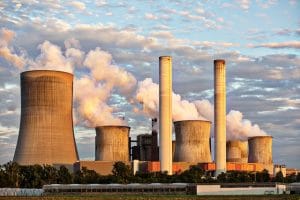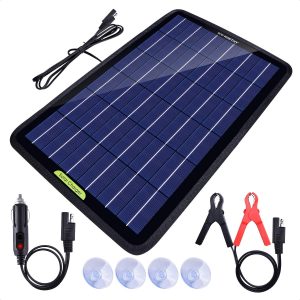The Role of Renewable Energy in Today's World
If you are striving to be more self-aware about the way your personal choices as a consumer are affecting the well-being of the planet, you should start by briefly looking around you. Pretty much everything you own and use on a daily basis needs electrical power to run.
In turn, electrical power is generated with the help of polluting fuels and other harmful alternatives with an undeniably negative effect on the atmosphere, landfills and water. Around forty percent of all carbon dioxide emissions at a global level are triggered by the generation of electricity with the help of fossil fuel combustion that creates the heat necessary for powering steam turbines. When these fuels burn, they produce CO2, which is the main greenhouse gas that causes global warming, the catastrophic problem that threatens the existence of Earth.
Renewable energy such as the energy from the sun and the wind are considered clean energy sources and they are the main components of the so-called clean energy revolution that more and more people choose to join every day. If you would like to know more about what are the best sources of renewable energy and how they could assist you with making an impact at home, read on.
Renewable Energy – The Innovation We All Need In Our Lives
 Renewable or clean energy refers to the energy that is generated by natural processes and sources that are replenished nonstop. We can mention the energy that comes from the sun or the wind that will continue to shine and blow in spite of them being available in certain weather conditions or at certain times.
Renewable or clean energy refers to the energy that is generated by natural processes and sources that are replenished nonstop. We can mention the energy that comes from the sun or the wind that will continue to shine and blow in spite of them being available in certain weather conditions or at certain times.
Lots of people mistakenly think that renewable energy is a new or innovative technology that uses the power of Mother Nature. In reality, humankind has been harnessing these natural sources of energy for centuries for generating heat, light or for transportation needs. For example, wind was used to power sailing boats or to grind grains in windmills long before the term “renewable energy” was even invented. The energy that comes from the sun has also helped our ancestors stay warm throughout the day and kindle fires. Unfortunately, over the last half of the millennia, we have started to gradually use energy sources that are dirtier, including gas and coal.
This is a shame, given the fact that renewable sources of energy are not only great at lowering our monthly bills, but they can also help us get closer to living a clean future powered by clean energy. The solar and wind generation industries are continuously being inserted into national electricity grids in different parts of the world. The great news is that this is done without having to sacrifice their reliability.
In other words, renewable energy can effectively replace the use of the so-called dirty fossils part of the power generation industry. These sources of clean energy trigger smaller carbon footprints and generate smaller amounts of other pollutants as well. However, keep in mind that not all all energy sources that are advertised as being renewable have, in fact, positive effects on the planet. For instance, we can mention the existence of large-sized hydroelectric dams as well as biomass that can harm the climate and the wildlife, among others.
Luckily, we can now benefit from more and more affordable and innovative means of harnessing and retaining the energy from the sun and the wind. This means renewable energy is turning into a more reliable and frequent source of power in several parts of the world, with over one-eighth of power generation in the United States represented by renewable energy. Renewables are expanding at both large and small scales, starting with solar panels installed on the rooftop of a home, which could sell power back to the national electrical grid or to large wind farms located out of the country. There are also plenty of countryside communities that use renewables to address their need for light and heat. While more growth is needed and expected in the upcoming years, the modernization of the grid and its turning into a smarter an safer one will smoothen the integration across a larger number of areas.
Let us take a closer look at a few sources of renewable energy and find out how to make use of them right inside your home. But first…
What Is Non-Renewable Energy?
 Also called dirty energy, non-renewable energy sources refer to the use coal, oil, and gas or other forms of fossil fuels. These energy sources come in limited amounts and they take a lot longer to replenish. When pumping gas into your vehicle at the gas station, you are in fact consuming a limited energy resource that is obtained from oil dating back to prehistoric times.
Also called dirty energy, non-renewable energy sources refer to the use coal, oil, and gas or other forms of fossil fuels. These energy sources come in limited amounts and they take a lot longer to replenish. When pumping gas into your vehicle at the gas station, you are in fact consuming a limited energy resource that is obtained from oil dating back to prehistoric times.
These dirty sources of energy are only present in certain areas of the globe, and some countries are richer than others when it comes to their resources.
Compared to the all-natural and fully replenishing wind and solar sources of energy that can be accessed by all countries around the world, non-renewable energy has its share of limitations and drawbacks. Among them, we can mention the way a country must rely on exports in order to buy the fossils needed for its citizens or the fact that most of these energy sources are endangering the planet and our health and well-being. Drilling for oil relies on strip-mining, which is a procedure that is connected to the pollution of water and earthquakes, while power plants that produce coal severely pollute the air. Combined, all these processes make global warming an even more palpable reality of our times.
Different Types Of Sources of Renewable Energy
Solar Energy
The fact that the systems used to harness the energy from the sun do not pollute the air generate any or create any greenhouse gas effects is one of the main reasons why they have become so popular in recent years. It is, however, important for these systems to be located in responsible areas in order their potentially negative impact on the environment.
Humankind has been enjoying the benefits of natural energy from the sun solar for several millennia, mostly for staying warm, growing crops, or dry food. According to a definition issued by the National Renewable Energy Laboratory, the earth benefits from more solar energy in 60 minutes than the energy used by all the citizens of the planet throughout an entire year.
Currently, the energy from the sun rays is used for anything from heating our homes and commercial spaces to warming water or powering electronics.
Solar cells, also called photovoltaic or PV cells contain silicon and similar materials that do a good job at changing the light from the sun into electricity.
- A distributed solar system will generate electricity to homes and businesses in a smaller area with the help of rooftop panels or through local projects belonging to the community for powering neighborhood.
- A floating solar farm, also called a “floatovoltaic” is a good solution for using water bodies and wastewater facilities that are not eco-sensitive.
Natural Energy From The Wind
Long gone are the days when wind mills were the only means of generating energy with the help of wind. Extremely tall and wide wind turbines are not the new standard in all parts of the planet. This renewable source of energy relies on naturally occurring wind to turn the blades of turbines which will in turn feed electric generators and generate electricity.
Wind is, in fact, the most affordable of all the renewables in most countries, with places like California, Iowa, or Texas in the US worth mentioning here as leaders. One of the main advantages of wind turbines is the fact that they can be placed pretty much in any location where where the speed of wind is high enough, including in open water, on an open plain or the top of a hill.
Natural Energy From Water Bodies
Also called hydropower, hydroelectric power is the primary source of renewable energy that generates electricity in the US. It generally uses bodies of water that move fast, usually inside rivers or using water that descents at fast speeds from higher points. The process relies on the spinning the of the blades of a turbine on a generator and the transformation of the water force into electricity.
However, as mentioned in the beginning of this post, a large hydroelectric dam is considered a non-renewable source of energy in many parts of the planet. Why? Basically, a mega-dam will divert and cut the naturally occurring flow of river water, while restricting people’s and animals’ access to the respective rivers. A smaller plant, on the other hand, should not trigger such damage to the environment, since it will only divert a small fraction of the water flow.
Energy From Organic Biomass
Biomass refers to plant- and animal-originating organic materials such as trees, crops, or waste wood. When these materials are burned, they release a type of chemical energy in the form of heat, which is responsible for generating electricity with the help of steam turbines.
Biomass is often times included on the list of renewables mentioned before. Nonetheless, there are plenty of examples of organic materials found inside forests, for example, that generate more pollution and higher carbon footprint levels compared to the use of fossil fuels.
The natural biodiversity of the planet is also influenced by biomass energy, in spite of the fact that sawdust from sawmills are fast to decompose and generate energy with the help of the low levels of released carbon.
How To Use Renewable Energy Sources At Home
 Solar power can be harnessed an used to power your entire house with the help of passive solar home designs or panels that use solar cells. He first alternative means your home will need to let the direct light from the sun enter through windows that will be facing South. The energy will be retained via the concrete, as well as the tiles and bricks known for their capacity to store warmth. You could start producing extra solar energy that you will be able to sell to the grid.
Solar power can be harnessed an used to power your entire house with the help of passive solar home designs or panels that use solar cells. He first alternative means your home will need to let the direct light from the sun enter through windows that will be facing South. The energy will be retained via the concrete, as well as the tiles and bricks known for their capacity to store warmth. You could start producing extra solar energy that you will be able to sell to the grid.
You could also rely on batteries as an affordable means of storing the extra energy from the sun and use during nighttime.
You could also consider investing in your very own small wind system, that you could install in your backyard. There are loads of mobile cell phone companies, as well as ranchers that rely on smaller wind farms. You could take advantage of the dealers that are ready fit and upkeep install, a wind turbine system destined for use at home, or embrace a DIY tutorial if you think you have the skills needed to install a wind turbines on your own. A series of factors such as your household’s need for electricity, as well as the speed of the wind and the zoning legislation could help you become more independent in terms of being on the grid.
Finally, you could also consider using geothermal heating pumps to use the constant temperature of the earth for cooling your home in the hot season, warming water or for for keeping your home warm in the cold season. Keep in mind you can always choose to store or sell the exces form the sun or the wind, and expect the retail price for it, so you have every reason to embrace it. Another healthy alternative is to purchase renewable energy from locals, if you are not yet willing to invest in your own solar panels or wind mills at home.
FAQ
Renewable energy is also called clean energy and it refers to the energy that is generated by natural processes and sources that are replenished nonstop. We can mention here the sun or wind energy that will continue to shine and blow in spite of them being available in certain weather conditions or at certain times.
Non-renewable energy is also referred to as dirty energy and it refers to the use of coal, oil, and gas or other forms of fossil fuels in order to generate electricity. These are limited and they take a lot longer to replenish.
The energy from the sun rays is used for anything from heating our homes and commercial spaces to warming water or powering electronics. Solar farms can generate electricity for several thousands of homes at once, with the help of mirroring procedures that can focus the light from the sun across several acres of PV cells.
This affordable renewable source of energy relies on naturally occurring wind to turn the blades of turbines which will in turn feed electric generators and, in turn, generate electricity.


